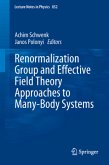This book offers an introduction to Chiral Perturbation Theory. Coverage starts with the Lagrangian of the strong interactions and general symmetry principles, then develops the basic concepts of Chiral Perturbation Theory in the mesonic and baryonic sectors.
Chiral Perturbation Theory, as effective field theory, is a commonly accepted and well established working tool, approximating quantum chromodynamics at energies well below typical hadron masses.
This volume, based on a number of lectures and supplemented with additional material, provides a pedagogical introduction for graduate students and newcomers entering the field from related areas of nuclear and particle physics.
Starting with the the Lagrangian of the strong interactions and general symmetry principles, the basic concepts of Chiral Perturbation Theory in the mesonic and baryonic sectors are developed. The application of these concepts is then illustrated with a number of examples. A large number of exercises (81, with complete solutions) are included to familiarize the reader with helpful calculational techniques.
Chiral Perturbation Theory, as effective field theory, is a commonly accepted and well established working tool, approximating quantum chromodynamics at energies well below typical hadron masses.
This volume, based on a number of lectures and supplemented with additional material, provides a pedagogical introduction for graduate students and newcomers entering the field from related areas of nuclear and particle physics.
Starting with the the Lagrangian of the strong interactions and general symmetry principles, the basic concepts of Chiral Perturbation Theory in the mesonic and baryonic sectors are developed. The application of these concepts is then illustrated with a number of examples. A large number of exercises (81, with complete solutions) are included to familiarize the reader with helpful calculational techniques.
From the reviews:
"The book under review gives a very good introduction into chiral perturbation theory. ... The book is very pedagogical and can read by students and researchers interested in the topic. ... The book does not only contain many exercises, but also the solutions to them. After reading and working through the book one will have no problems in understanding the current research topics in chiral perturbation theory." (Stefan Weinzierl, Zentralblatt MATH, Vol. 1232, 2012)
"The book under review gives a very good introduction into chiral perturbation theory. ... The book is very pedagogical and can read by students and researchers interested in the topic. ... The book does not only contain many exercises, but also the solutions to them. After reading and working through the book one will have no problems in understanding the current research topics in chiral perturbation theory." (Stefan Weinzierl, Zentralblatt MATH, Vol. 1232, 2012)








